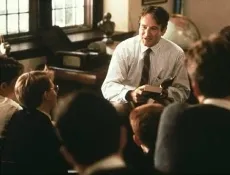
Posted Fri Oct 9, 2009 at 12:00 PM PDT by Joshua Zyber
|
Editor's Note: Each Friday, High-Def Digest's own HD Advisor will answer a new round of questions from our readers. If you have home theater questions you need answered, send an email to [email protected]. |
Answers by Joshua Zyber
Is Film "HD"?
Q: I recently went to the one-showing-only theatrical re-release of 'The Wizard Of Oz' in HD. I noticed during the introduction, they said it was, "For the first time ever in HD." Then, "It will look as good as it did on opening night." I recall other questions on this site about how the original film stock has a much higher potential resolution than even 1080p, and that even 1080p is a downgrade from the original film. So, if that is the case, hasn't it always been "HD"? (I realize for this showing, it was shown from a digital source.) Would it be correct to say all movies viewed in theaters are HD? And will we eventually see movies in theaters shown from film be advertised as HD?
A: In many respects, this is really a matter of semantics. Technically, "high definition" is a video term that refers to the resolution of a video signal. Film is a photochemical medium that does not have lines of resolution or pixels. Therefore, it is not accurate to refer to film as "HD," even if that film (like 35mm or 65mm) has more equivalent detail than high definition video does.
On the other hand, digital projection is a video format and can be called "HD." That recent screening of 'Oz' was projected from HD digital video.
Does that mean that you'll never see a film screening advertised as "HD"? Probably not. When it comes to marketing and advertising, technical accuracy rarely comes into play. I've seen 35mm still camera film marketed as "High Definition." I've even seen eyeglasses labeled that way. "HD" is a buzzword that everyone wants to use these days. But just because something is branded like that doesn't mean that the term is being used correctly.
Lossless 7.1 Soundtracks from Older Blu-ray/HD DVD Players
Q: Toshiba HD-A1, HD-A2, HD-A30, HD-XA1, and Sony BDP-S1. Those models don't support DTS-HD Master Audio format. What happen if I play DTS-HD MA 7.1 movies on these players when connected via HDMI to a receiver that supports lossless audio with 7.1 speakers setup? Will it come out as DTS 5.1 core only or DTS-ES 6.1?
A: As you noted, all of those Toshiba HD DVD players referenced, as well as the first-generation Sony Blu-ray player, do not support lossless audio. When you play a disc with a DTS-HD Master Audio soundtrack, the players will only be able to decode and output the standard DTS core, not the MA extension.
So your question is whether that DTS core will be 5.1 channels or 6.1, if the MA track is 7.1? (Standard DTS does not offer 7.1 format.) For example, 'Pan's Labyrinth' (Blu-ray | HD DVD) has DTS-HD MA 7.1 audio on either format. From my understanding, the core of a DTS-HD MA track works the same as regular DTS on DVD. The track can be either 5.1 or 6.1 depending on how the studio authors it. If I had to guess, I'd assume that most are probably authored in 5.1 format, with the added channels included in the MA extension.
Connecting Old Video Sources to an HDTV
Q: I am trying to connect my Laserdisc player to my new LED Samsung HDTV. However, the TV only has one input set for the old-fashioned RCA (yellow, red, and white). I also have a region-free DVD player as well that I need to connect to that. Is there an adaptor out there that's HDMI on one end of the cable and the old-fashioned Yellow/Red/White on the other end?
A: If I'm reading you correctly, your TV has extra HDMI inputs that you're not currently using, and you'd like to plug old analog video equipment into those. What you're asking for would require a device that can digitize the analog signal from a Composite video cable, as well as analog audio, and output them all over HDMI. This is possible, but impractical and probably needlessly expensive for a standalone device.
Do you have an A/V receiver with HDMI connections? If so, most modern receivers will do what you're asking. You can plug all of your video sources into the receiver first. Then the receiver will digitize the analog signals, and output everything over a single HDMI connection. You can switch between which sources you want to output over that HDMI connection at the receiver.
Failing that, you may just want to try a simple analog RCA A/V switcher. These can be purchased rather cheaply, and will allow you to plug multiple devices into a single TV input.
Some questions that the HD Advisor receives are best answered with a consensus of opinions from our readers. If you can help to answer the following question, please post your response in our forum thread linked at the end of this article. Your advice and opinions matter too!
How to Recognize a Bootleg Blu-ray?
Q: How can you tell a burned Blu-ray from an authentic one? With such high-tech and sophisticated printers today, I figure someone could easily print a high quality label for the front of the disc to make the burned copy look legitimate. Is there any other way to distinguish a bootleg Blu-ray from an authentic Blu-ray?
Check back soon for another round of answers. Keep those questions coming.
Joshua Zyber's opinions are his own and do not necessarily reflect those of this site, its owners or employees.
See what people are saying about this story in our forums area, or check out other recent discussions.
The latest news on all things 4K Ultra HD, blu-ray and Gear.